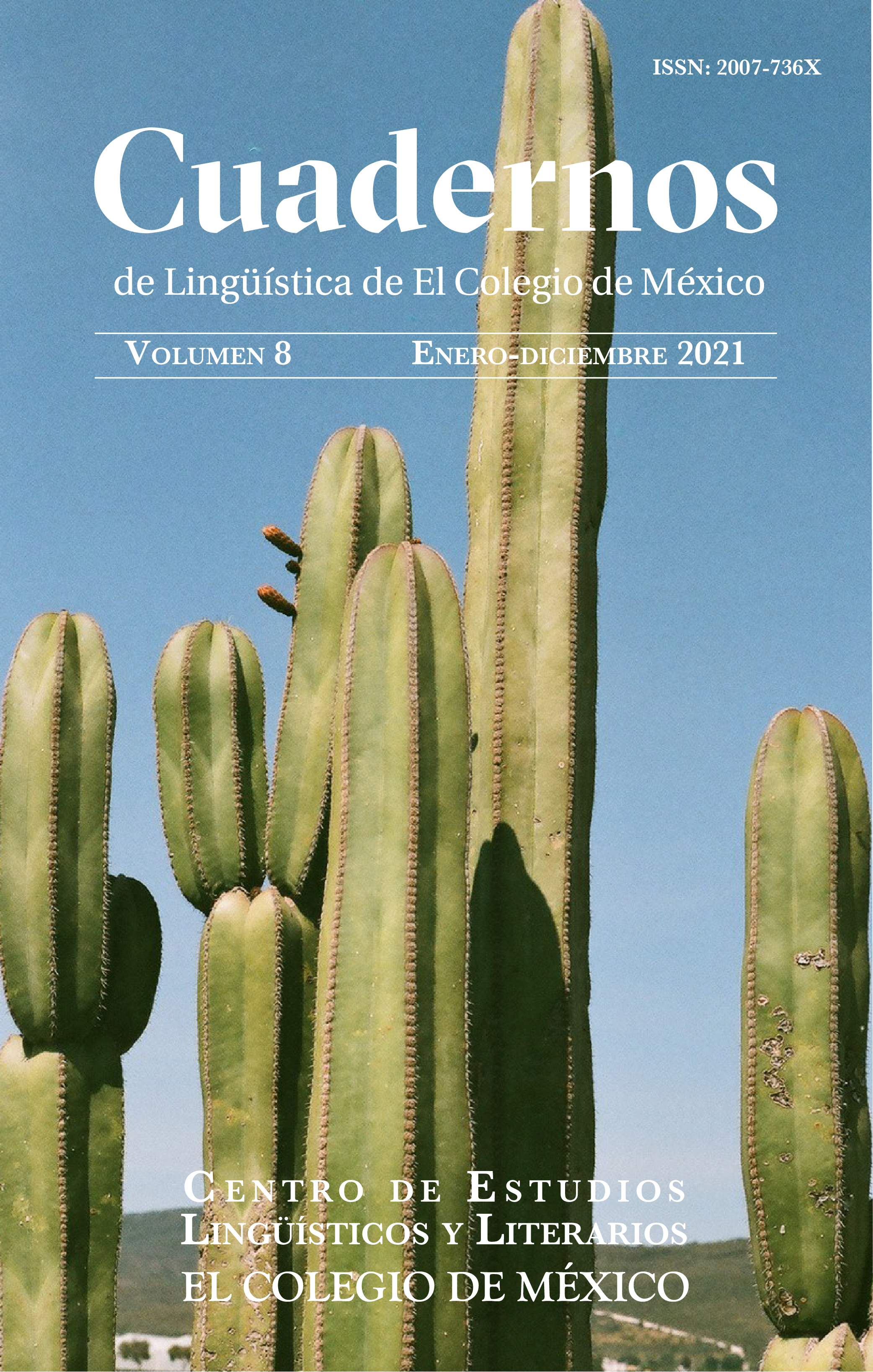Evidence of inflectional morphology in literal paraphasias and neologisms produced in a type of aphasia. A case study
DOI:
https://doi.org/10.24201/clecm.v8i0.183Keywords:
inflectional morphology, aphasia, neologisms, clinical linguisticsAbstract
The study of inflectional morphology has been mainly centered around Broca’s and Wernicke’s aphasias and has been concluded that there is different damage between the two, the first one presents alterations in the inflectional affixes, but not in the lexical root, while the second one presents the opposite pattern (Ullman et al. 1997). Our investigation tries to delve into these descriptions, which is why we focus on the analysis of inflectional morphemes that occur in: (i) nouns and verbs that present some type of paraphasia, and (ii) in nominal and verbal neologisms, produced by a patient with aphasia acoustic-amnesic. This syndrome is produced by a lesion in posterior zones —medium sectors of the temporal lobe— that causes a deficit in the audio-verbal retention (Luria 2015; Quintanar 1994). Methodologically, we start from the perspective of a case study (Caramazza 1986), to exhaustively describe the composition of paraphasias and neologisms. Our data comes from three dialogues videotaped, their transcription and further analysis. According to the results, we saw conservation of inflectional suffixes in both types of words, while lexical roots were found to have been altered. Finally, these results were consistent with the hypothesis that lesions in posterior zones caused lexical alterations (Ullman 2004), and alterations in the selection (Jakobson 1971a; Luria 1980); while grammatical elements, such as inflectional suffixes, are preserved.
Downloads
References
Ahlsén, E. 2006. Introduction to neurolinguistics. Países Bajos: John Benjamins Publishing Company.
Akhutina, Tatiana. 2015. Luria’s classification of aphasias and its theoretical basis. Aphasiology 30(8). 878–897.
Ardila, Alfredo. 1992. Errores lingüísticos en pacientes afásicos: un análisis de las parafasias. Revista Latina de Pensamiento y Lenguaje 1(1). 1–10.
Ardila, Alfredo. 2006. Las afasias. Florida: Florida International University.
Ardila, Alfredo. 2008. Neuropsicología del lenguaje. En Tirapu-Ustárroz, Javier & Ríos-Lago, Marcos & Maestú, Fernando (eds.), Manual de neuropsicología, 99–122. Barcelona: Viguera editores.
Ardila, Alfredo. 2014. Aphasia handbook. Florida: Florida International University.
Aronoff, Mark & Fudeman, Kirsten. 2004. What is morphology? Oxford: Blackwell Publishing.
Ávila, Raúl. 1977. Afasias: selección, combinación, signos y fonemas. Nueva Revista de Filología Hispánica (NRFH). 26(2). 277–285. https://doi.org/10.24201/nrfh.v26i2.487
Bastiaanse, Roelien & Bol, Gerard & van Mol, Sofie & Zuckerman, Shalom. 2002. Verb movement and finiteness in language impairment and language development. En Fava, Elisabetta (ed.), Clinical linguistics. Theory and applications in speech pathology and therapy, 119–130. Ámsterdam: John Benjamins.
Bates, Elizabeth & Friederici, Angela & Wulfeck, Beverly. 1987. Grammatical morphology in aphasia: evidence from three languages. Córtex 23(4). 545–574.https://doi.org/10.1016/S0010-9452(87)80049-7
Bosque, Ignacio & Gutiérrez-Rexach, Javier. 2009. Fundamentos de sintaxis formal. Madrid: Akal.
Bosque, Ignacio. 1983. La morfología. En Abad Nebot, Francisco & García Berrio, Antonio (coords.), Introducción a la lingüística, 115–154. Madrid: Alhambra.
Caramazza, Alfonso. 1986. On drawing inferences about the structure of normal cognitive systems from the analysis of patterns of impaired performance: the case for single-patient studies. Brain and Cognition 5(1). 41–66. https://doi.org/10.1016/0278-2626(86)90061-8
Di Tullio, Ángela. 2005. Manual de gramática del español. Buenos Aires: Waldhunter editores.
Domínguez, Alberto & Cuetos, Fernando. 2011. Morfología. En Cuetos, Fernando (coord.), Neurociencia del lenguaje. Bases neurológicas e implicaciones clínicas, 65–76. Madrid: Editorial Médica Panamericana. https://dialnet.unirioja.es/servlet/libro?codigo=555469
Escandell-Vidal, María Victoria. 2018. Reflexiones sobre el género como categoría gramatical. Cambio ecológico y tipología lingüística. En Ninova, M (ed.), De la lingüística a la semiótica: trayectorias y horizontes del estudio de la comunicación, 1–17. Sofía: Universidad de S. Clemente de Ojrid.
Fuchs, Zuzzana & Polinsky, Maria & Scontras, Gregory. The differential representation of number and gender in Spanish. The linguistic review 32(4). 1–31. https://doi.org/10.1515/tlr-2015-0008
Gallardo Paúls, Beatriz. 2002. Fronteras disciplinarias: pragmática y patología del lenguaje. En Hernández Sacristán, Carlos & Serra Alegre, Enrique (coords.), Estudios de lingüística clínica, 129–174. Valencia: Ñau Libres.
García Manga, M. Carmen. 2010. La etimología popular como fenómeno peculiar del lenguaje. Cádiz: Universidad de Cádiz. (Tesis de doctorado).
García Manga, M. Carmen. 2012. Aproximación discursiva y cognitiva a la motivación por etimologización. Pragmalingüística 20. 120–148. https://doi.org/10.25267/Pragmalinguistica.2017.i25
Givón, T. 2001. Syntax. An introduction. Ámsterdam: John Benjamins Publishing co.
Golden, Charles & Purisch, Arnold & Hammeke, Thomas. 1979. The Luria-Nebraska neuropsychological battery: a manual for clinical and experimental uses. Nebraska: Nebraska University Press.
Goodglass, Harold & Berko, Jean. 1960. Agrammatism and inflectional morphology in English. Journal of speech and hearing research 3(3). 257–266. https://doi.org/10.1044/jshr.0303.257
Goodglass, Harold & Kaplan, Edith & Barresi, Barbara. 2005. Test de Boston para el Diagnóstico de la Afasia. Formato abreviado. Cuadernillo de registro. Diana Klajn (trad.). Madrid: Médica Panamericana.
Goodglass, Harold & Kaplan, Edith & Weintraub, Sandra. 1996. Test de Vocabulario de Boston. En Goodglass, Harold & Kaplan, Edith (eds.), Evaluación de la afasia y de trastornos relacionados. Madrid: Médica Panamericana.
Guillén Escamilla, J. E. 2018. Una ruta dual en el procesamiento morfológico: evidencia de los neologismos en la afasia sensorial. Logos 28 (1). 41–53. http://dx.doi.org/10.15443/rl2804.
Guillén Escamilla, Josaphat Enrique. 2020. Hacia una caracterización lingüística contemporánea de las afasias propuestas por A. R. Luria. Revista de Investigación en Logopedia 10(1). 17–29. https://doi.org/10.5209/rlog.65113
Guillén Escamilla, Josaphat Enrique & Martínez, Dulce Nohemí & Romero Martínez, Ángel Omar. 2019. El origen del cochino espinoso o el procesamiento de palabras compuestas en un tipo de afasia: un estudio de caso. Lengua y Habla 23(1). 380–398.
Hamster, Wolfgang & Langner, Wieland & Mayer, Klaus. 1980. Tübinger-Lurija-Christensen Neuropsychologische Untersuchungsreihe. (TÜLUC). Weinheim: Beltz.
Haspelmath, M. 2002. Understanding morphology. Oxford: Oxford University Press.
Jakobson, Roman. 1956. Two aspects of language and two types of aphasic disturbances. En Halle, Morris & Jakobson, Roman (eds.), Fundamentals of language, 69–95. The Hague: Mouton.
Jakobson, Roman. 1971a. Linguistics types of aphasia. En Jakobson, Roman (ed.), Selected writings. Vol. II. Word and Language, 307–333. París: Mouton.
Jakobson, Roman. 1971b. Toward a linguistic classification of aphasic impairments. En Jakobson, Roman, Selected writings. Vol. II. Word and Language, 289–306. París: Mouton.
Jarema, Gonia. 2008. Impaired morphological processing. En Stemmer, Brigitte & Whitaker, Harry A. (eds.), Handbook of the neuroscience of language, 137–146. Ámsterdam: Elsevier Ltd. https://doi.org/10.1016/B978-0-08-045352-1.00013-6
Labov, William. 1983. Modelos sociolingüísticos. Madrid: Cátedra.
Luria, Alexander Romanovich. 1980. Fundamentos de neurolingüística. Barcelona: Toray-Masson.
Luria, Alexander Romanovich. 2015. Las funciones corticales superiores del hombre. México: Fontamara.
Manga, Dionisio & Ramos, Francisco. 2000. Luria-DNA. Diagnóstico Neuropsicológico de Adultos. Madrid: TEA Ediciones.
Manga, Dionisio & Ramos, Francisco. 2006. Luria Inicial. Evaluación neuropsicológica en la edad preescolar: manual. Madrid: TEA Ediciones.
Martínez-Ferreiro, Silvia. 2003. Verbal inflectional morphology in Broca’s aphasia. Barcelona: Universidad Autónoma de Barcelona. (Tesis de maestría).
Penke, Martina. 1998. Die grammatik des agrammatismus. The grammar of agrammatism: a linguistics analysis of word order and inflection in Broca’s aphasia. Berlín: De Gruyter. https://doi.org/10.1515/9783110914689
Penke, Martina. 2008. Morphology and language disorder. En Ball, Martín J. & Perkins, Michael R. & Müller, Nicole & Howard, Sara(eds.), The handbook of clinical linguistics, 212–227. Chicester: Blackwell Publishing co. https://doi.org/10.1002/9781444301007.ch13
Picallo, M. Carme. 2008. Gender and number in Romance. Lingue e linguaggio 7(1). 47–66.
Quintanar Rojas, Luis & Solovieva, Yulia & León-Carrión, José. 2011. Evaluación clínica neuropsicológica de la afasia Puebla-Sevilla. Puebla: Benemérita Universidad Autónoma de México.
Quintanar Rojas, Luis & Solovieva, Yulia. 2002. Análisis neuropsicológico de las alteraciones del lenguaje. Revista de Psicología General y Aplicada 55(1). 67–87.
Quintanar Rojas, Luis & Solovieva, Yulia. 2012. Evaluación neuropsicológica de la actividad mnésica. Manuscrito sin publicar.
Quintanar Rojas, Luis. 1994. Modelos neuropsicológicos en afasiología. Puebla: Universidad Autónoma de Puebla.
Quintanar Rojas, Luis. 2002. La escuela neuropsicológica soviética. Revista Española de Neuropsicología, 4 (1), 15–41. https://dialnet. unirioja.es/servlet/articulo?codigo=2011198
RAE. 2010. Nueva gramática de la lengua española. España: Espasa.
Sánchez Bernardos, María Luisa. 1990. Alteraciones del procesamiento fonológico en el habla: patrones de error y modelos. Una revisión. Estudios de Psicología 11(41). 93–110. https://doi.org/10.10 80/02109395.1990.10821132
Solovieva, Yulia; Lázaro García, Emelia & Quintanar Rojas, Luis. 2008. Aproximación histórico-cultural: Fundamentos teórico-metodológicos. En Eslava-Cobos, Jorge & Mejía, L. & Quintanar Rojas, Luis & Solovieva, Yulia (eds.), Los trastornos del aprendizaje: perspectivas neuropsicológicas, 145–182. Bogotá: Instituto Colombiano de Neurociencias.
Solovieva, Yulia & Quintanar Rojas, Luis. 2013. Evaluación neuropsicológica breve para adultos. México: Benemérita Universidad Autónoma de México.
Solovieva, Yulia & Quintanar-Rojas, Luis. 2005. Acerca de los mecanismos de la afasia acústico-mnésica. Revista Española de Neuropsicología 7. 17-34.
Solovieva, Yulia & Quintanar-Rojas, Luis. 2007. Análisis neuropsicológico de las dificultades en la lecto-escritura. En Asociación Mundial de Educadores Infantiles (ed.), Jornadas Internacionales. La animación a la lectoescritura, 6–18. España: AMEI.
Solovieva, Y., Lázaro, E. & Quintanar Rojas, L. 2008. Aproximación histórico-cultural: Fundamentos teórico-metodológicos. En Eslava, Jorge, Mejía, L., Quintanar Rojas, Luis & Solovieva, Yulia (eds.), Los trastornos del aprendizaje: perspectivas neuropsicológicas. Colombia: Magisterio.
Stump, Gregory. 2017. Inflection. En Spencer, Andrew & Zwicky, Arnold M. (eds.), Handbook of morphology, 11–43. Nueva Jersey: John Wiley & Sons, Inc.
Thompson, Cynthia K. & Cho, Soojin & Hsu, Chien-Ju & Wieneke, Christina & Radamaker, Alfred & Weitner, Bing Bing & Mesulam, M-Marsel & Weintraub, Sandra 2012. Dissociations between fluency and agrammatism in primary progressive aphasia. Aphasiology 26(1). 20–43. doi: 10.1080/02687038.2011.584691
Tsvetkova, L. S. 1998. Afasia y enseñanza rehabilitatoria. Rusia: Educación.
Ullman, Michael T. 2001. The declarative/procedural model of lexicon and grammar. Journal of Psycolinguistics Research 30. 37–69. https://doi.org/10.1023/A:1005204207369
Ullman, Michael T. 2004. Contributions of memory circuits to language: the declarative/procedural model. Cognition 92(1-2). 231– 270. doi: 10.1016/j.cognition.2003.10.008
Ullman, M. T., Corkin, S., Coppola, M., Hickok, G., Growdon, J. H., Koroshetz, W. J., & Pinker, S. 1997. A neural dissociation within language: Evidence that the mental dictionary is part of the declarative memory, and that grammatical rules are processed by the procedural system. Journal of cognitive neuroscience 9. 266-276
Van der Lely, Heather K. J. & Pinker, Steven. 2014. The biological basis of language: insight from developmental grammatical impairments. Trends Cogn Sci 818(11). 586–595. doi: 10.1016/j.tics.2014.07.001.
Varela, Soledad. 1992. Fundamentos de morfología. España: Síntesis.
Varela, Soledad. 2018. Morfología léxica: la formación de palabras. España: Gredos.
Wilshire, Carolyn. 2008. Cognitive neuropsychological approaches to word production in aphasia: beyond boxes and arrows. Aphasiology 22(10). 1019-1053
Xomskaya, Evgenia. 2002. El problema de los factores en la neuropsicología. Revista Española de Neuropsicología 4(2-3). 151–167.
Published
How to Cite
-
Abstract1258
-
PDF (Español)559
-
XML (Español)15
-
EPUB (Español)73
-
Kindle (Español)113
-
MP3 (Español)14
Issue
Section
License
Copyright (c) 2021 José de Jesús Fitta García

This work is licensed under a Creative Commons Attribution-NonCommercial-NoDerivatives 4.0 International License.
Authors retain copyright of their work and are free to disseminate it, make copies for any use, and/or deposit in any repository or archive of their choice, but they grant Cuadernos de Lingüística de El Colegio de México the right to publish the work for the first time. Authors agree to acknowledge Cuadernos de Lingüística de El Colegio de México as the site of original publication of their article / note / review through proper citation.
Articles appearing in Cuadernos de Lingüística de El Colegio de México are made available to readers under a Attribution-NonCommercial-NoDerivatives 4.0 International.









